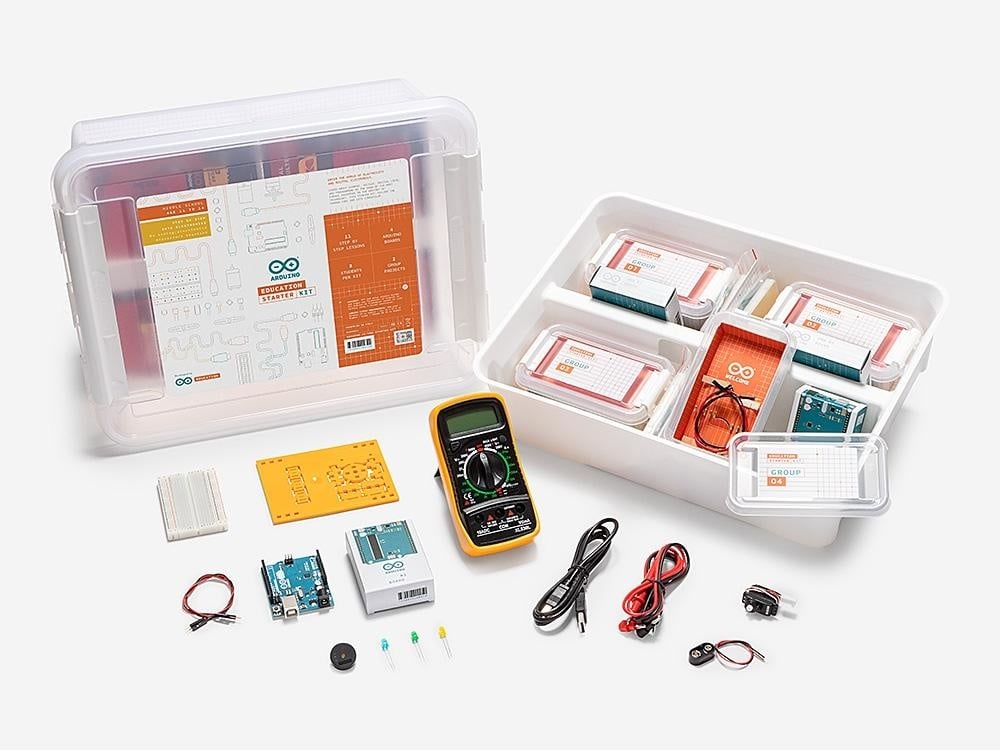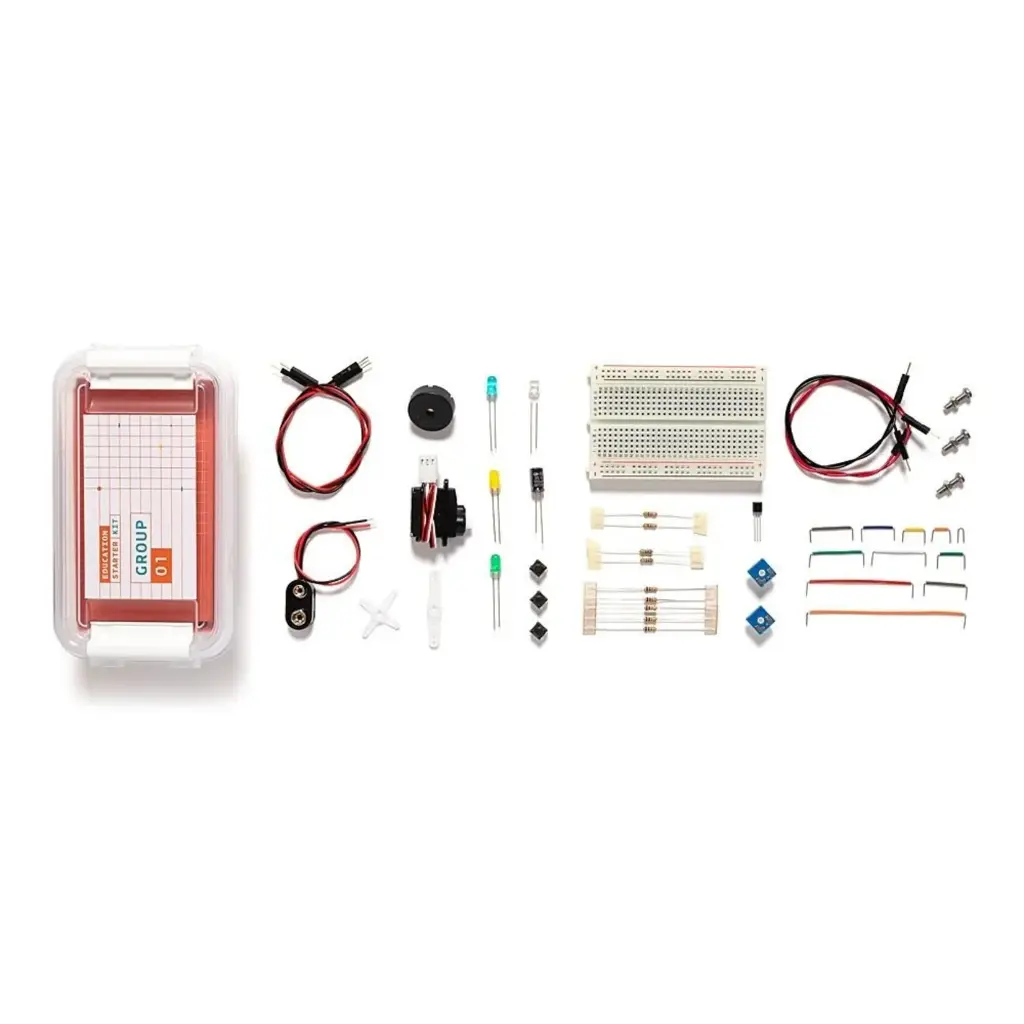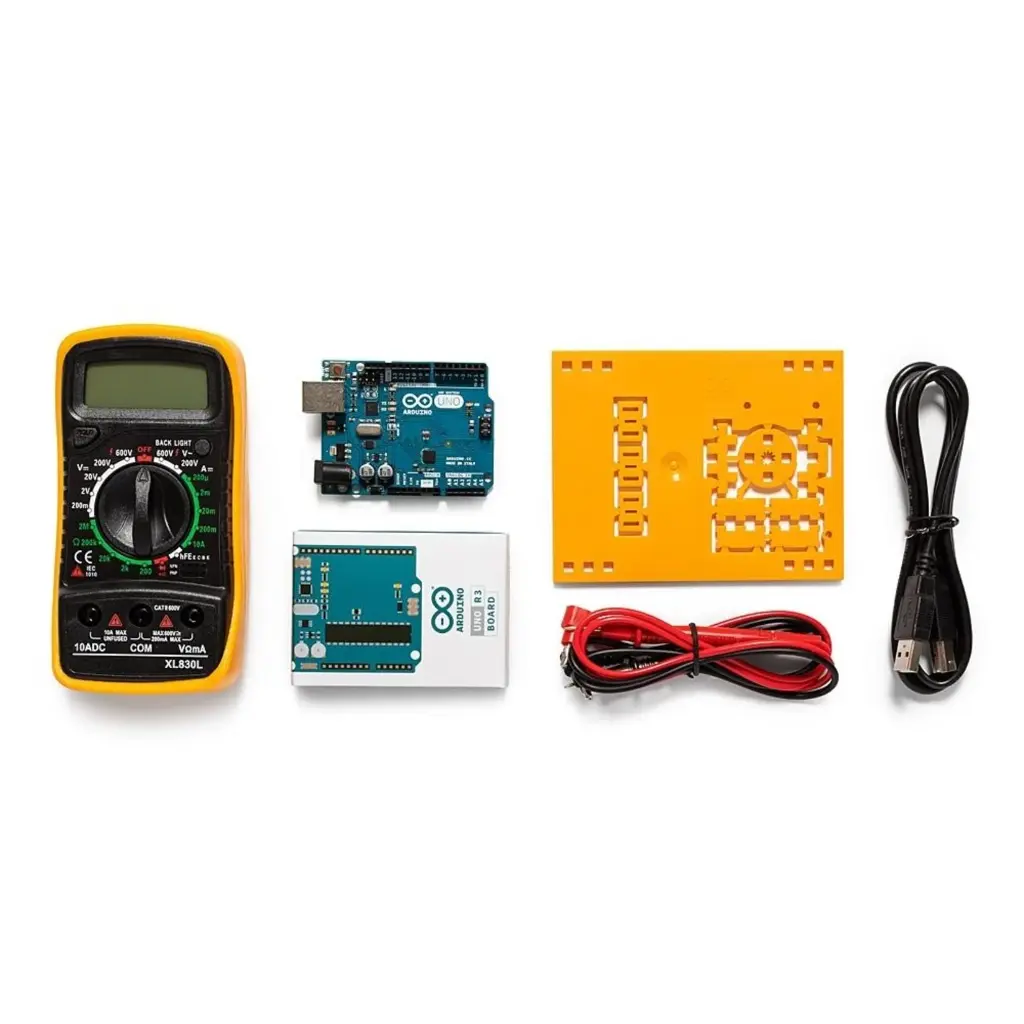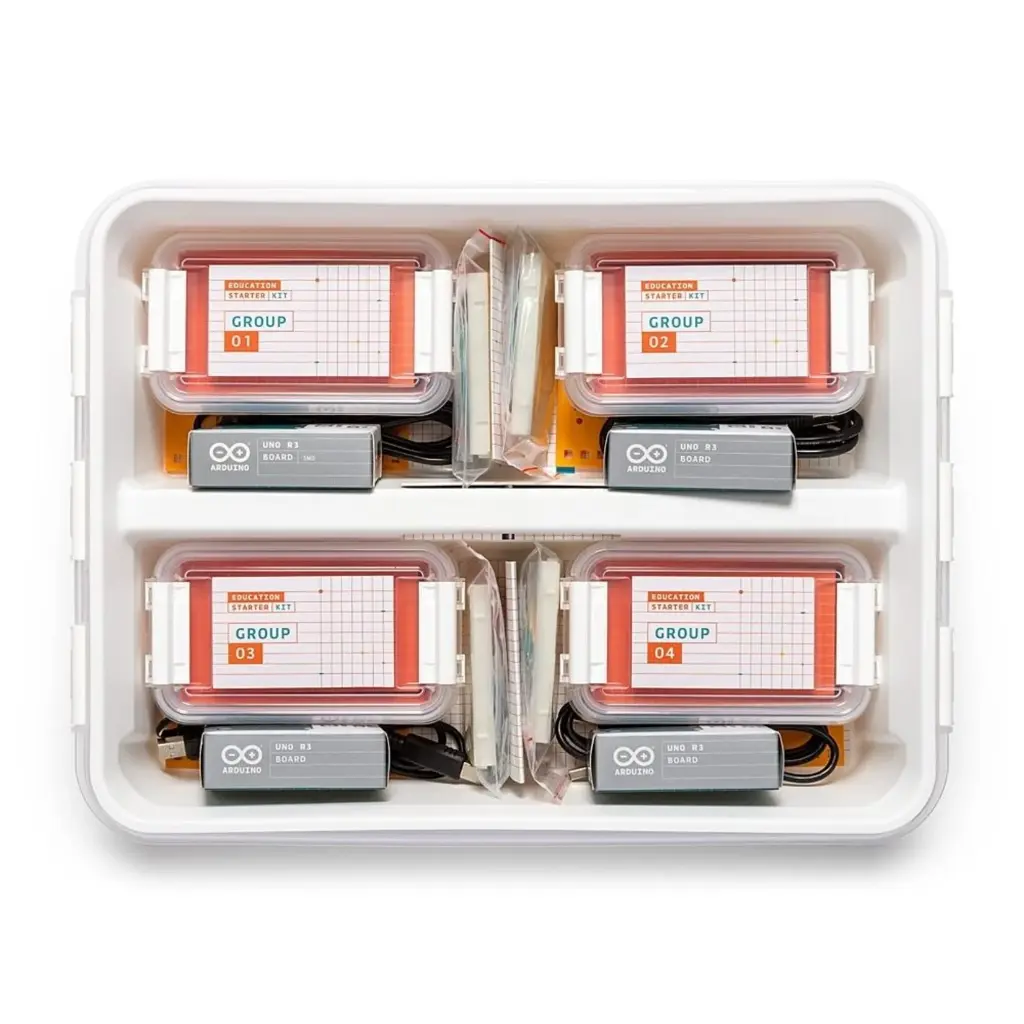Arduino® Education Starter Kit
AKX00023
Internal Reference:
ARD-AKX00023
Barcode:
7630049202429
Overview
Deze set (ARD-AKX00023) heeft dezelfde inhoud als 4 keer de Arduino Education Student kit (ARD-AKX00025-R).
The software and PDF documents are available in English..
Teach middle school students the basics of programming, coding, and electronics. No prior knowledge or experience is necessary as the kits guide you through step-by-step, you are well-supported with teacher guides, and lessons can be paced according to your students’ abilities. You can integrate the kit throughout the curriculum, giving your students the opportunity to become confident in programming and electronics with guided sessions and open experimentation. You’ll also be teaching them vital 21st-century skills such as collaboration and problem-solving.
The Arduino Education Starter Kit contains all the hardware and software you need for eight students (in groups of 2). You get step-by-step-lessons, teacher notes, exercises, and for a complete and in-depth class experience there’s also extra optional resources including activities, concepts, history, and interesting facts.
The online platform contains the teacher content, nine 90-minute lessons, and two open-ended group projects that teach students coding and electronics. Each lesson builds off the previous one, giving students a further opportunity to apply the skills and concepts they have already learned. Students also get an engineering logbook that they complete as they work through the lessons.
The beginning of each lesson provides an overview, estimated completion times, and learning objectives. Throughout each lesson, there are teacher notes and information that help the lesson go smoothly. Extension ideas are provided at the end of each lesson.
Documentatie
Online Platform
- All the classes will be available online, both for educators and students, following in a linear way.
Logbook
- The logbook is a downloadable PDF workbook that the students need to complete throughout the lessons.
- The teacher can print as many copies as needed for the classroom and it can be completed either individually or in groups.
- The teacher also gets a downloadable logbook with the solutions.
Invention Spotlight
- In the Invention Spotlight, students learn about different inventions and facts behind the topics and lessons, giving them a broader view and historical insight.
Resources
- Extra hints, such as after-class research, ideas to develop intecurricula studies, presentations and short information, that give students a more comprehensive experience.
Vocabulary
- The lessons also come with words that might be unfamiliar to students. There are numerous vocabulary activities a teacher can do with their students. These activities can be considered as in-class extension activities or as additional assignments to be completed on their own.
Overview lessons
Getting Started ( 30 mins). In this lesson the students get familiar with the kit´s material. Learn about electrical safety, how to setup the software and create their first program.
Lesson 1 - Electricity Fundamentals (90 mins). In this lesson the students explore some of the basic concepts of electricity and build their first simple circuit while learning about the components that make up the circuit.
Lesson 2 - Ohm's Law ( 90 mins).The students explore one of the physical laws that determine how electricity behaves in a circuit: Ohm's Law . They will learn, by building, the difference between parallel and series circuits and will investigate how electrical measurements behave using a multimeter as a tool.
Lesson 3 - Traffic Signals (90 mins). In this lesson, students are introduced to the Arduino Software (IDE) and program their first light circuit that controls how the circuit operates.
Lesson 4 - Dimmer Switch (90 min). The students learn about the potentiometer and how they can be used manually to control a circuit. As a result, they will build an LED circuit where the Arduino board will control the brightness of the LEDs based on the position of the potentiometer. As the students code their circuit they will be introduced to concepts such as variables, conditional statements and serial communication.
Lesson 5 - Project Holiday Lights ( 90 mins).The students will complete an open-ended project to design, build and program their own holiday light circuit. The project must follow the project's objectives, criterias and constraints.
Les 6 - Sport Robot (90 min). In this lesson, the students will learn how to use a servo motor to create a simple sports robot. They will program the robot to hit, kick or throw a ball.
Lesson 7 - Windshield wipers (90 mins). This lesson introduces new programming concepts to the students such as nested conditionals, switch-case structures, and loops. The students learn the new concepts by programming and building a windshield wiper circuit.
Lesson 8 - Musical Keyboard ( 90 mins). In this lesson, students learn about piezo buzzers and how to produce different sounds, tones and music. With that understanding, the student will build and code a musical keyboard.
Lesson 9 - Light Wave Radar (90 mins). Studenten zullen hun Arduino-bord en een fototransistor gebruiken om de intensiteit van het licht te meten en leren het basisprincipe over hoe informatie door lichtgolven wordt overgedragen.
Lesson 10 - Project Greenhouse Control System (180 mins). The students will complete an open-ended project to design, build and program a climate-control system for a greenhouse. The project must follow the project's objectives, criterias and constraints.
Wat zit er in de doos
- 4 Arduino UNO rev 3
- 4 Starter Kit mounting base Easy-to-assemble plastic base
- 4 Battery Snap 9v
- 8 Batteries 9v
- 4 Breadboard 400 points
- 4 Capacitor – 100uF
- 4 Female-male Jumper Wires (red)
- 4 Female-male Jumper Wires (black)
- 20 LEDs (red)
- 20 LEDs (green)
- 20 LEDs (yellow)
- 20 LEDs (blue)
- 4 Multimeters
- 4 Piezo Buzzer [PKM17EPP-4001-B0]
- 4 Phototransistors
- 8 Potentiometer 10kOhms
- 20 Push Button
- 4 Resistors - 1 kOhms
- 20 Resistors - 10 kOhms
- 20 Resistors - 220 Ohms
- 20 Resistors - 560 Ohms
- 70 Jumper Wires
- 4 Stranded jumper wires (red)
- 4 Servo Motor
- 4 Temperature sensor [TMP36]
- 4 USB Cable
- 12 M 3 Screw
- 12 M3 Bolts







